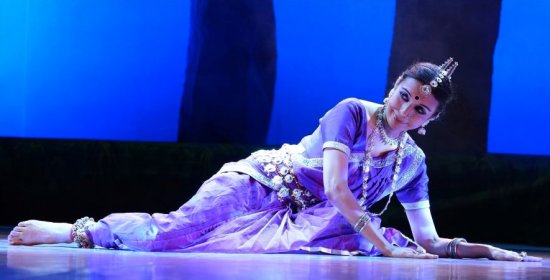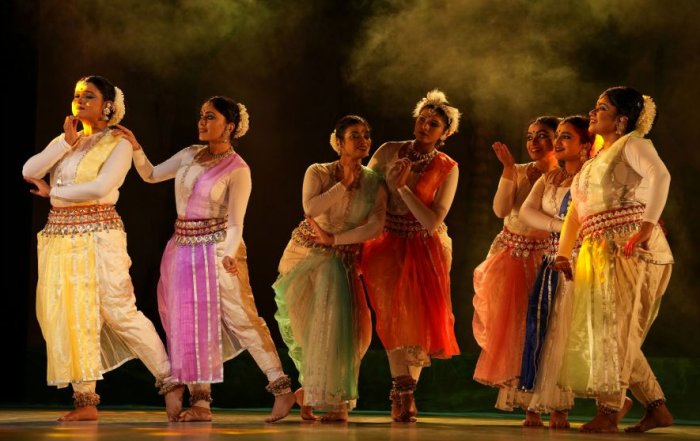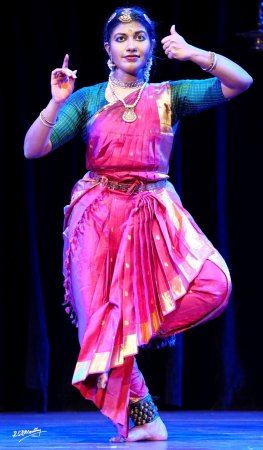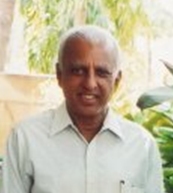
|   |

|   |
Performances to enchant - Satish Suri e-mail: satishism@yahoo.co.in February 18, 2024 Hansika: A visual delight in Odissi Photos: Prof K.S.Krishnamurthy The Sanjali Centre for Odissi Dance captivated audiences with their stunning adaptation of Pyotr Ilyich Tchaikovsky's iconic ballet 'Swan Lake.' Under the masterful direction and choreography of Sharmila Mukerjee, the centre showcased the power and versatility of Odissi dance in a scintillating one-hour performance at the A.D.A Rangamandira, Bengaluru, on the 4th of February.  Sharmila Mukerjee Sharmila Mukerjee skillfully reimagined the tragic story of Odette, a princess cursed to live as a swan, and her sister's rivalry for the affection of a prince. The Odissi dancers brought the tale to life with grace, power and emotional depth. Praveen D Rao's brilliant musical composition seamlessly blended classical and contemporary elements, incorporating traditional instruments like the sitar, flute, violin and mardala. The result was a pulse quickening score that perfectly underscored the beauty and drama of the dancers' movements. The performance was further enhanced by breathtaking costumes tailored to the production's theme. Combined with evocative stage design and lighting, strategic use of shadows, the forest and lake settings created an immersive and otherworldly environment.  This successful adaptation serves as a triumphant testament to the enduring appeal of 'Swan Lake', but perhaps more importantly, to the adaptability of Odissi. The dance form, known for its lyrical and graceful qualities, proved capable of expressing the full spectrum of emotions inherent in the classic ballet. Sharmila Mukerjee, Srijita Sanyal, Surajit Som, Suranjana Endow, Anuradha Ghosh, Anushree Padmanabha, Nandita Bhattacharya, Sritama Mukhopadhyay, Subhashree Das, Sweta Panda, Isita Roy, Raima Nanda, Shryansi Das, Tanseem Mohanty, Briti Mukherjee, Anika Bhagat and Debanjan Ghosh are all accomplished Odissi dancers who showcased their talent in the rendition of 'Swan Lake'. They mesmerized the viewers with their elegant poses and emotive expressions that brought the story to life on stage. Margam by Vaibhav Arekar: From the form to the formless Photo: Bangalore International Centre Vaibhav Arekar presented a Bharatanatyam Margam under the aegis of Kalavahini Trust's quarterly dance program curated by Malavika Sarukkai at the Bangalore International Centre on the 8th of February 2024. The recital commenced with a solo mridangam prelude by Satish Krishnamurthy, setting the mood for Vaibhav's subsequent performance.  Vaibhav Arekar Vaibhav commenced his Bharatanatyam presentation with 'Akaasha,' featuring an Alarippu comprising 24 aksharas in udhgatta tala, composed by Guru Bharadwaj. He eloquently presented "Ananda natana prakasam" in the raga Kedaram, set to misra chapu talam, a composition of Muthuswami Dikshitar. Vaibhav's rendition of this piece radiated with dynamic and serene moments, seamlessly blending intricate jathis with moments of stillness, showcasing his versatility and mastery of the art form. The focal point of the Bharatanatyam performance was the varnam "Mohamaginen inda velayil," a masterpiece composed by Dandayudapani Pillai. A lovestruck nayika confides in her sakhi, expressing her deep yearning for Lord Shiva in his divine form as Nataraja, the cosmic dancer. The dancer skillfully depicted the nayika's emotional journey, intricately weaving a narrative that portrayed both the dance itself and the inner turmoil of the nayika's heart. The nayika's heartfelt expressions of love and longing were conveyed with utmost sincerity, as she wonders if Lord Shiva will acknowledge and reciprocate her feelings. The rhythmic elements, expertly conceived by mridangist Satish Krishnamurthy and complemented by the assured nattuvangam of Kaliswaran Pillai, played a pivotal role in enhancing the interpretive choreography, seamlessly blending with the dancer's movements. While the first half showcased a traditional blend of bhakti (devotion) and sringar (romantic love) highlighting the nayika's inner passion and engagement, the mood shifted dramatically in the charanam. Here, the nayika's fervent desire transformed into bold assertiveness, as she fearlessly expresses her love for Lord Shiva, disregarding societal norms and expectations. This transformation embodied a sense of confidence and empowerment, reflecting a nuanced portrayal of feminine strength and resilience. The rendition of the ashtapadi "Priye charusheele" depicted Lord Krishna seeking forgiveness from his beloved Radha, who is upset with him. The artiste's performance was notable for its deeply expressive abhinaya, skillfully conveying subtle emotions and nuances. Particularly commendable was Vaibhav's portrayal of traditionally feminine emotions within the character of Lord Krishna, showcasing a transcendent quality that transcended gender roles and stereotypes, ultimately elevating the performance to a sublime artistic expression of love and devotion. The thillana in raga Purvi, a composition of Vaidyanatha Bhagavathar Iyer, was a culmination of the performance, infusing it with a burst of energy and liveliness. With each movement and gesture, the dancer skillfully brought out the intricate melodic patterns inherent in the composition, showcasing a deep understanding of rhythm and melody. The rhythmic complexity of the thillana was handled with precision and flair, the lively movements adding a dynamic dimension to the performance, captivating the audience with its vibrant choreography. The artiste's expressions were filled with joy and enthusiasm, reflecting the celebratory mood of the piece. As the music swirled and pulsed, his graceful movements filled the stage with a sense of exhilaration, drawing the audience into the rhythmic tapestry. The musical landscape was brought to life by the talented ensemble, with Karthik Hebbar's soulful vocals serving as the focal point of the performance. Satish Krishnamurthy's mastery of the mridangam added depth and rhythm to the composition, his beats resonating with energy and precision. Kaliswaran Pillai's skilful nattuvangam complemented the music perfectly. Mahesh Swamy's melodious flute added another layer of richness to the music, its enchanting tones weaving seamlessly with the vocal melodies and rhythmic beats. Together, the ensemble created a musical tapestry infusing the performance with infectious energy and a lively tempo. 'Maathe' by Manasvini K.R. at Navvarsh Mahotsav 2024 Photo: Prof K.S.Krishnamurthy The Navvarsh Mahotsav organized by the Saraswathi Educational and Cultural Trust, commenced with a mesmerizing performance by Manasvini K.R. on the opening day of the festival, the 10th of February at Seva Sadan, Bengaluru. Her presentation titled 'Maathe' unfolded as a sublime exploration of the divine feminine through the representation of three significant goddesses: Kamakshi, Meenakshi, and Visalakshi. Each deity symbolizes different aspects of femininity, power, and cosmic energy, contributing to the rich tapestry of the performance as the artiste seamlessly transitioned between the personas. With each shift in character, the dancer conveyed a range of emotions, from tender devotion to fierce determination, capturing the essence of each goddess with sensitivity.  Manasvini KR The presentation commenced with an electrifying nritta segment, featuring the Kamakshi Thiruppugazh, a devotional hymn dedicated to Goddess Kamakshi. Through intricate footwork and precise rhythmic patterns, the dancer brought the essence of Kamakshi's divine energy to life. Her performance exuded dynamism and vitality, captivating the audience from the outset. However, the pinnacle of the performance arrived with the rendition of the varnam "Maathe malayadhwaja" set to the soul-stirring Khamas raga. A highlight of the rendition was the portrayal of various goddess forms, including the gentle and nurturing demeanour of Shatodari Shankari and the awe-inspiring fierceness of Chamundeshwari. Through subtle facial expressions, graceful hand gestures, and fluid movements, the dancer painted a vivid picture of divine femininity. Incorporating the subtle use of Karanas in her performance provided an exquisite and sculptural edge to Manasvini's movement profile. The performance transitioned to "Annapoorni Visalakshi," a composition that underscored the compassionate and nurturing aspect of the divine mother. Here, the dancer's abhinaya took centre stage, as she depicted the goddess's boundless love and generosity through poignant expressions and gestures. The vocalist Susha Rangarajan's soulful rendition added depth to the portrayal, creating a seamless fusion of music and dance. Throughout the performance, the intricate rhythms of the nattuvangam, skillfully executed by S. Vijaykumar, provided a solid foundation for the dancer's movements. The decision to feature only the khanjira by the mridangist Manohar Balatchandirane in certain segments added a unique texture to the performance, allowing for moments of quiet reflection amidst the vibrant energy of the dance. The performance was further elevated by the enchanting violin accompaniment provided by B. Anantha Krishnan through his soulful refrains and melodic improvisations. In conclusion, Manasvini's portrayal of 'Maathe' was a mesmerizing celebration of the divine feminine, marked by its depth, emotion, and artistic finesse. With her impeccable technique, expressive storytelling, and profound connection to the spiritual essence of the goddesses, she left an indelible impression on the audience, transporting them into the realm of divine beauty and grace.  Bangalore based Satish Suri is an avid dance rasika besides being a life member of the Music and Arts Society. |